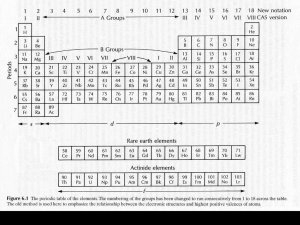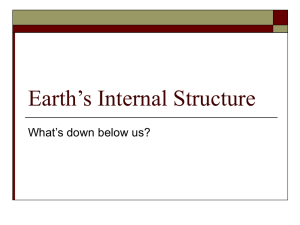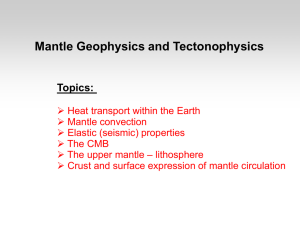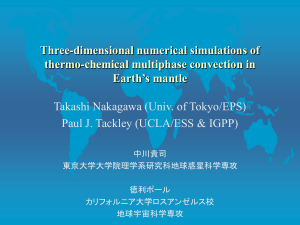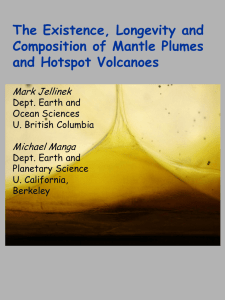Thermal structure
advertisement
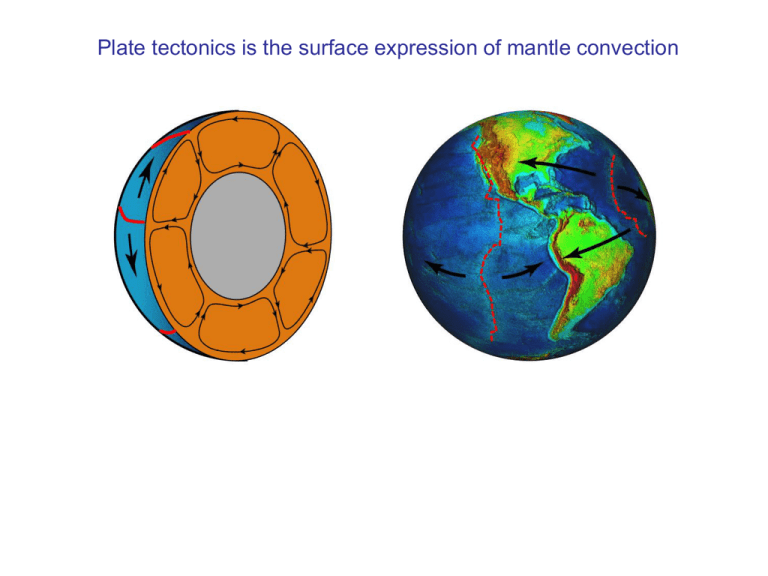
Plate tectonics is the surface expression of mantle convection Plate tectonics provides the chemical sources of life Plate tectonics and geochemical cycles • Mantle convection results in partial melts • Volcanism delivers nutrients and gases to the crust, ocean and atmosphere • Convection continually recycles nutrients • Plate interactions maintain topography Whole Earth structure Layered structure • structure we can most easily observe, via seismology • seismic layers reflect chemical, thermal, and mechanical differences Chemical structure • consequence of planet formation and • ongoing differentiation through melting • inferences about whole-earth chemistry can be made from melt products Thermal structure • mostly adiabatic, but • density (compositional) differences may restrict convection to “layers” • thermal boundary layers separate layers that can’t mix Mechanical structure • dependent on composition and temperature • controls convection • poorly understood Layered Structure Global seismology • structure we can most easily observe, via seismology • seismic velocity reflects chemical, thermal, and mechanical properties • seismic layers reflect first-order differences in these things • a reference, 1D (radially symmetric) velocity model exists for the earth • tomography reveals structure relative to that reference model Layered Structure 1D Earth Model Observed Peter Shearer PREM Chemical structure Effects of planet formation • Ken’s first lecture • segregate the core, maybe lowermost mantle, early melt differentiation Effects of melting • incompatible elements are enriched in continental crust • mantle is depleted in these elements • some parts of the mantle that haven’t yet melted may exist Effects of convection • enriched crustal components are returned to the mantle via subduction • subducted slabs may accumulate in the TZ or D’’ • it is still not clear how well mixed is the whole mantle Basalt Gabbro diorite Small percentage melts form interconnected networks QuickTime™ and a TIFF (Uncompressed) decompressor are needed to see this picture. 3-D distribution of melt around grain boundaries for (a) dihedral angles less than 60° and (b) greater than 60° For small dihedral angles there is a continuous, interconnected network of melt Earth’s thermal structure Geotherm • temperature as a function of depth in the earth Internal heat sources and transfer mechanisms • sources: mostly radioactive decay • transfer: conduction, convection/advection Adiabatic gradient • the temperature gradient due to isentropic decompression • can be determined if thermodynamic properties are known • generally characterized by a potential temperature Thermal boundary layers • temperature gradients in a region between non-mixing layers • the lithosphere, transition zone, and CMB are examples The mantle adiabatic temperature gradient An adiabatic temperature gradient is the temperature gradient resulting from isentropic pressure changes. An isentropic pressure change involves a volume change (via compression or decompression) but no change in heat (i.e. no conductive heat transfer). • When rising mantle decompresses, it expands - work is done by the volume - so potential energy is lost, and total energy decreases Since no heat enters the system, T decreases • For sinking mantle, it is the opposite - work is done on the volume to compress it (by gravity) T increases Mantle viscosity • Viscosity is a measure of how much a material will deform under an applied shear stress. ( y = ˙dux/dy ) • The viscosity, , of mantle rock is temperature dependent. • The temperature dependence of mantle viscosity, (T), is non-linear. • (T) decreases rapidly as T approaches the solidus. • The solidus is the temperature at which mantle rocks begin to melt. Conductive heat transfer, thermal boundary layer An internally heated solid with (T), away from conducting boundaries, will tend toward an adiabatic temperature gradient close to the melting temperature • material rises dz along an adiabat • it cools with decompression • it is as the same temperature as it’s surrondings • T(z) is adiabatic • material rises and cools • at T2 it is warmer than it’s surroundings • the material will continue to rise • unstable, convects • will establish a new geotherm as heat is transferred upward • material rises and cools • at T2 it is cooler than it’s surroundings • the material will sink back to it’s point of neutral buoyancy • it will continue to heat internally Note: this curve is made up. We don’t know the geotherm that well. Note: these curves are made up. We don’t know these things that well. Earth’s thermal structure Geotherm • temperature as a function of depth in the earth Internal heat sources and transfer mechanisms • sources: mostly radioactive decay • transfer: conduction, convection/advection Adiabatic gradient • the temperature gradient due to isentropic decompression • can be determined if thermodynamic properties are known • generally characterized by a potential temperature Thermal boundary layers • temperature gradients in a region between non-mixing layers • the lithosphere, transition zone, and CMB are examples Mechanical structure • For the most part, Earth’s mechanical structure is equivalent to it’s viscosity structure • Viscosity structure is temperature dependent and non-linear, with viscosity decreasing near the melting temperature. • Viscosity is also strongly dependent on water content • Large mechanical contrasts exist between the lithosphere and asthenosphere, which are mechanically defined, and between the lower mantle and core and between the inner and outer core • Phase transitions play an important role in the mechanical behavior of the convecting mantle Moving across layer boundaries Kellog, van der Hilst Clapeyron curves


